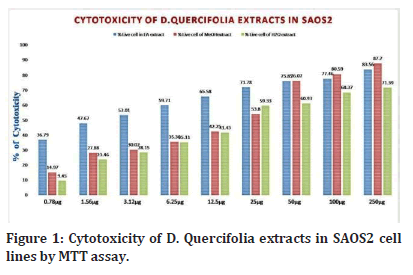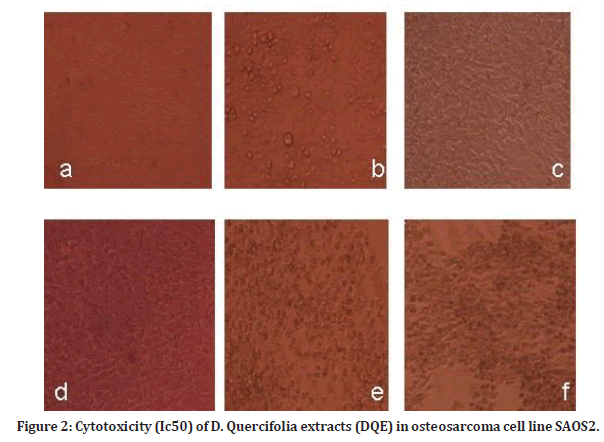Research Article - (2023) Volume 11, Issue 2
Screening the anticancer activity, cytotoxicity and anti-osteoarthritic activity of Drynaria quercifolia through Saos2 cell line studies
Lakshman RR1, Vasanth S1, Bupesh G2*, Balachandar V3 and Saravanan KM4
*Correspondence: Bupesh G, Natural Products and Tribal Health Research, Department of Forestry, Nagaland University, India, Email:
Abstract
In the present work, we investigated cytotoxicity activity against SAOS2 cell lines, Drynaria quercifolia, a medicinal plant having the elements of a Southern India recipe for cancer therapy, was chosen. The MTT assay was performed to determine the cell type's cytotoxic activity. After testing several concentrations in three different plant extracts, such as methanol, ethanol and aqueous extracts against cell lines, the active plant extracts were diluted and tested for calculating IC50. Plant extracts (D. quercifolia) demonstrated specific activity against cancer and osteoarthritic cell lines as compared to normal cells and should be explored further for active chemicals.
Keywords
Medicinal plants, Drynaria quercifolia, Anti-cancer activity, Cytotoxicity, Antiosteoarthritic activity
Introduction
Chemical synthesis or isolation from natural sources can be used to obtain these therapeutic drug molecules [1,2]. Regarding the overall success rate in drug discovery, chemicals from botanical sources are more effective [3- 5]. Countries such as India, Africa, and China have a long history of well-documented traditional medicine [6]. The initial listing of prospective species for biological activity screening is an essential procedure to proceed further [7,8]. When the biological activity of the plant is known from its traditional use, this strategy can be used [9,10]. This method aims to identify the chemicals that cause the activity based on their biological activity. Drynaria quercifolia belonging to the Polypodiaceae family, is one such plant that has been used in India for centuries to cure inflammation, rheumatism, headaches, bone fractures, jaundice, and other ailments [11]. The epiphytic fern has a slender, fleshy, spreading rhizome
heavily covered in soft reddish-brown scales.
D. quercifolia has been used to treat Tuberculosis, fever, dyspepsia, and cough. This medicine has been traditionally used in the treatment of diarrhoea, typhoid, cholera, jaundice, fever, headaches, skin ailments, and syphilis in the past [12]. The plant has also been discovered to help strengthen and heal sinews, muscles, and bones. Drynaria is used in a different medicinal combination to treat rheumatism [13,14]. Traditional Chinese medicine uses Drynaria rhizome topically to promote hair growth and cure baldness and is also used to treat hyperthyroidism [15]. Pain from traumatic injuries, such as sprains and contusions with bruising and swelling, is treated with D. quercifolia and various herbal combinations [16, 17]. Considering all the above, we have screened the therapeutic activity of plants by using MTT assay (a calorimetric assay to measure cell metabolic activity) and phase contrast microscopy (cell culture and live cell imaging).
Materials and Methods
MTT assay
The MTT assay is a colorimetric, quantitative method for determining cell survival and growth. The metric being measured is the metabolic activity of living cells. After Solubilization with DMSO, metabolically active cells convert pale yellow tetrazolium salt (MTT) to a purple water-insoluble formazan product that can be easily measured. The absorbance from the formazan product formed directly correlates with the number of viable cells. Osteosarcoma cell line (Saos2) Cells (50 X 103) were seeded in a 24-well plate and treated with various doses of D. Quercifolia extracts (DQE) at varied periods. After washing with PBS, the cells were treated with MTT (0.5 mg/mL) in DMEM (without phenol red) for 4 hours at 37 ºC. The medium was removed, and the resulting formazan product was dissolved in DMSO. A multimode plate reader (Thermo Fischer, USA) was used to measure absorbance at 570 nm and 650 nm for measuring cell survival and background, respectively. The studies were carried out in triplicate, with the percentage of live cells calculated compared to the control group. Statistical analysis of three independent experiments and calculation of IC50 were performed using Graphpad Prism version 5 for Windows (Graphpad Prism Software, USA).
Phase contrast microscopy
The morphology of the Saos2 cells was directly observed using inverted phase contrast microscopy (Nikon Eclipse TS 100).
Results
Anticancer activity measured by MTT assay
The viability of Saos2 cells in the presence of D. quercifolia extracts with different chemicals like ethyl- acetate, methanol, hexane and water was investigated using an MTT assay.
The ability of D. quercifolia extracts to cause toxicity towards Saos2 cells was assessed by MTT assay. When the cells were exposed to different concentrations of A D. Quercifolia extracts a very significant decrease in viability was observed. Treatment with 3.2 μg/mL of EA extract decreased the viability to 53 % at 24 h. When treated with a similar concentration of MeOH extract and H2O extract D. Quercifolia for 24 h, the viability was observed at 30.02 % and 28.15 %, respectively. 50 % toxicity was observed in the treatment of only 25 μg/mL of MeOH extract and H2O extract at 24 h. The maximum level of toxicity was observed in Saos2 cells treated with 250 μg/mL of all the D. Quercifolia extracts at 24h.
The IC50 values obtained were IC50 were compared with the positive control doxorubicin drug. Figure 1 showed a-Cell Control Saos2, b-Methanolic DQE (21.815μg), c-HexaneDQE (32.120μg), d-Aqueous DQE (25.55μg), e-Ethyl acetate (18.52μg), f-Doxorubicin (11.24μg) respectively. The anticancer activity of Saos2 cells in the figure revealed that the ethyl acetate and methanolic extract obtained the anticancer activity in a dose-dependent manner.

Figure 1. Cytotoxicity of D. Quercifolia extracts in SAOS2 cell lines by MTT assay.
Phase contrast microscopy
Phase contrast microscopy is a simple and easy method to compare the morphological changes in normal and treated cells (Figure 2). Control Saos2 cells showed typical growth patterns with smooth and flattened cells, which were well separated and spread throughout the plate. They had a large nucleus with many spherical nucleoli. When treated with different extracts of D. quercifolia induced changes in their morphology. Even 25.55μg of Aqueous DQE induced the development of cytoplasmic blebs at the periphery of the cell cluster at 24 h. Membrane dissolution was observed in a few regions when treated with 32.120μg of Hexane DQE and 18.52μg of Ethyl acetate (Figure 2). When treated with 21.815μg of Methanolic DQE, cells formed vacuoles and drastic membrane damage at 24 h. After treatment with Doxorubicin (11.24μg) at 24 h, the shrinkage of cytoplasm, cells got rounded off, and detachment of cells from the substratum with dense regions was observed (Figure 2).

Figure 2. Cytotoxicity (Ic50) of D. Quercifolia extracts (DQE) in osteosarcoma cell line SAOS2.
Conclusion
The tribal people of India, Africa and China use D. quercifolia as a medicinal plant. In the present study, we evaluate the cytotoxicity of D. Quercifolia by MTT assay and phase contrast microscopy. The plant extracts were very promising in showing anticancer, cytotoxicity, and anti-osteoarthritic potential. The findings of this study add some weight to the fern's supposed therapeutic properties. This plant has a lot of medicinal promise, but more study is needed to extract bioactive components and figure out what's going on.
References
- Saravanan KM, Zhang H, Senthil R, et al. Structural basis for the inhibition of SARS-CoV2 main protease by Indian medicinal plant-derived antiviral compounds. J Biomol Struct Dyn 2022; 40:1970-1978.
- Saravanan KM. The practice of remdesivir for treating covid-19 during pandemic. 2022; 1:65-68.
- Vijayaram S, Kannan S, Saravanan KM, et al. Preliminary phytochemical screening, Antibacterial potential and GCMS analysis of two medicinal plant extracts. Pak J Pharm Sci 2016; 29:819–822.
- Pothiaraj G, Manoranjani M, Pitchaikani S, et al. Investigation of therapeutic and immunomodulatory activity of Bacopa saponin from Bacopa monnieri. South African J Bot 2022; 151:639–650.
- APB B, Bhuvaneswari S, Raj L, et al. A review on the potential species of the zingiberaceae family with anti-viral efficacy towards enveloped viruses. J Pure Appl Microbiol 2022; 16:796–813.
- Sen S, Chakraborty R. Revival, modernization and integration of Indian traditional herbal medicine in clinical practice: Importance, challenges and future. J Tradit Complement Med 2017; 7:234–244.
- Zhang H, Yang Y, Li J, et al. A novel virtual screening procedure identifies Pralatrexate as inhibitor of SARS-CoV-2 RdRp and it reduces viral replication in vitro. PLOS Comput Biol 2020; 16:e1008489.
- Le HTT, Murugesan A, Ramesh T, et al. Molecular interaction of HIC, an agonist of P2Y1 receptor, and its role in prostate cancer apoptosis. Int J Biol Macromol 2021; 189:142–150.
- Sen S, Chakraborty R, De B. Challenges and opportunities in the advancement of herbal medicine: India’s position and role in a global context. J Herb Med 2011; 1:67–75.
- Sundaram KKM, Bupesh G, Saravanan KM. Instrumentals behind embryo and cancer: A platform for prospective future in cancer research. AIMS Mol Sci 2022; 9:25–45.
- Prasanna G, Anuradha R. A comprehensive review on phytopharmacological activities of drynaria quercifolia L. Int J Pharmacogn Phytochem Res 2016; 12–24.
- Ramesh N, Viswanathan M, Saraswathy A, et al. Phytochemical and antimicrobial studies on Drynaria quercifolia. Fitoterapia 2001; 72:934–936.
- Sujin RM, Jeeva S, Subin RM. Phytochemical and pharmacological studies of oak leaf fern, drynaria quercifolia (L.) j sm: A review. Phytochem Pharmacol 2021; 373–387.
- Saravanan KM, Krishnaswamy S. Analysis of dihedral angle preferences for alanine and glycine residues in alpha and beta transmembrane regions. J Biomol Struct Dyn 2015; 33:552–562.
- Pawar DV, Chandrashekar DKT, Mishra DR, et al. Drynaria quercifolia plant extract as a bone regenerative material in the treatment of periodontal intrabony defects: Clinical and radiographic assessment. J Dent Med Sci 2017; 16:93–99.
- Karthikeyan V. Pharmacognostical standardization and phytochemical profile of rhizomes of Drynaria quercifolia (Linn). Eur J Biomed Pharm Sci 2016; 3:278–284.
- Saravanan KM, Selvaraj S. Performance of secondary structure prediction methods on proteins containing structurally ambivalent sequence fragments. Biopolymers 2013; 100.
Indexed at, Google Scholar, Cross Ref
Indexed at, Google Scholar, Cross Ref
Indexed at, Google Scholar, Cross Ref
Indexed at, Google Scholar, Cross Ref
Indexed at, Google Scholar, Cross Ref
Indexed at, Google Scholar, Cross Ref
Indexed at, Google Scholar, Cross Ref
Indexed at, Google Scholar, Cross Ref
Indexed at, Google Scholar, Cross Ref
Indexed at, Google Scholar, Cross Ref
Indexed at, Google Scholar, Cross Ref
Indexed at, Google Scholar, Cross Ref
Indexed at, Google Scholar, Cross Ref
Author Info
Lakshman RR1, Vasanth S1, Bupesh G2*, Balachandar V3 and Saravanan KM4
1Bio Medical Sciences Lab, Bharath Institute of Higher Education and Research, Chennai, India2Natural Products and Tribal Health Research, Department of Forestry, Nagaland University, Zunheboto, Nagaland, India
3Stem cell and Regenerative Medicine/Translational Research, Department of Zoology, Central University of Punjab (CUPB), Bathinda, Punjab, India
4Depatment of Biotechnology, Bharath Institute of Higher Education and Research, Chennai, Tamilnadu, India
Citation: Lakshman RR, Vasanth S, Bupesh G, Balachandar V, Saravanan KM, Screening the Anticancer Activity, Cytotoxicity and Anti-Osteoarthritic Activity of Drynaria Quercifolia through Saos2 Cell Line Studies, J Res Med Dent Sci, 2023, 11(2):234-236.
Received: 25-Jan-2023, Manuscript No. jrmds-23-89588; Accepted: 28-Jan-2023, Pre QC No. jrmds-23-89588; Editor assigned: 28-Jan-2023, Pre QC No. jrmds-23-89588; Reviewed: 11-Feb-2023, QC No. jrmds-23-89588; Revised: 16-Feb-2023, Manuscript No. jrmds-23-89588; Published: 23-Feb-2023
